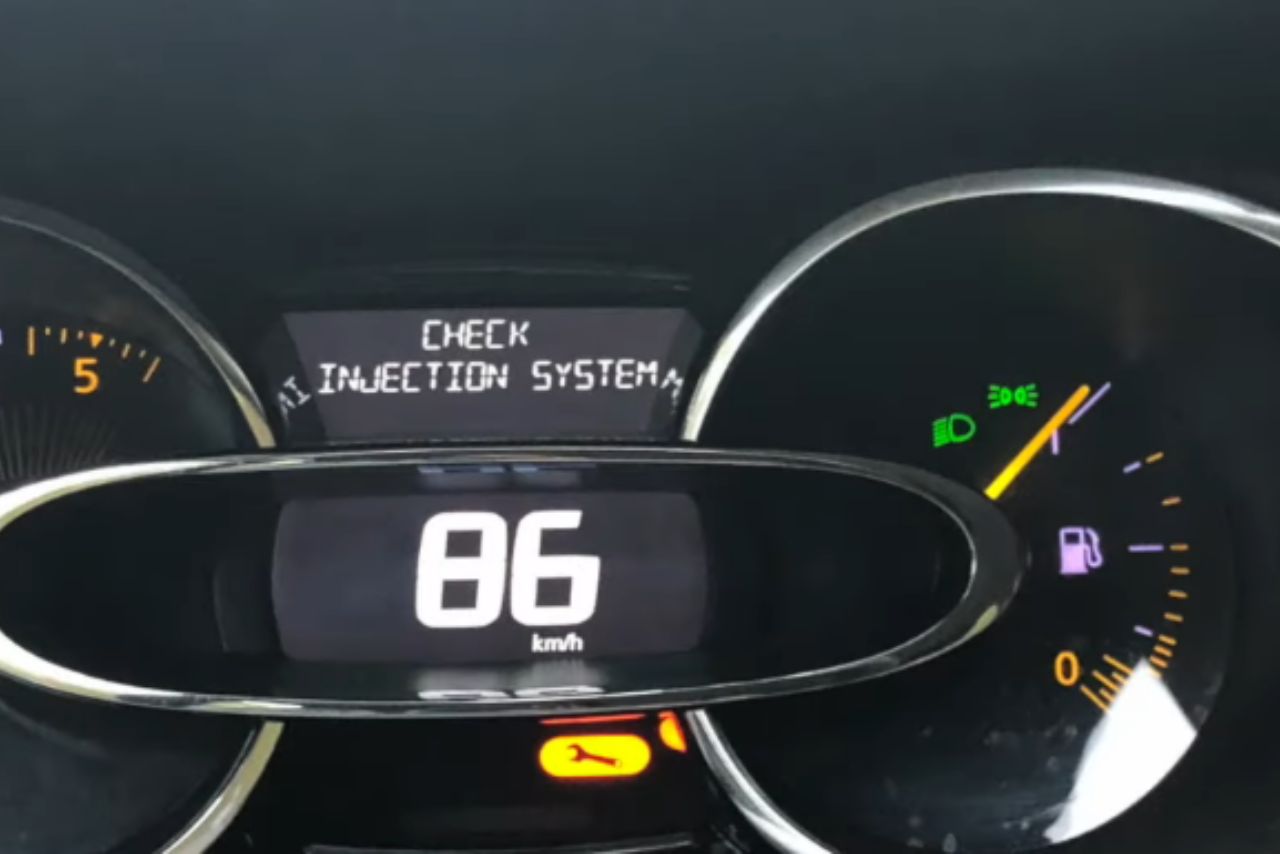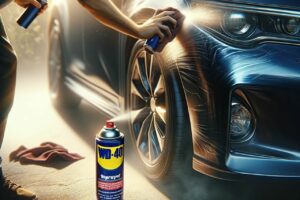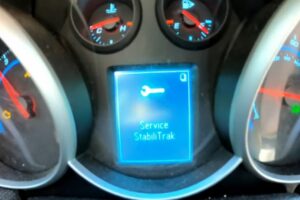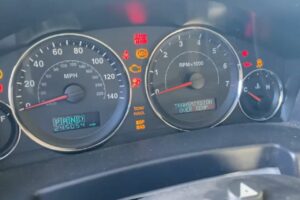Have you ever found the “Check Injection System” warning light flashing on your Renault’s dashboard and wondered what it could mean?
Check Injection System Light in Renault can be triggered by multiple issues, ranging from a faulty mass air flow sensor (MAF) or exhaust gas recirculation (EGR) valve to dirty fuel injectors, defective fuel pump, malfunctioning oxygen sensor, electrical hitches or even software glitches.
But don’t fret! The solution might be as simple as replacing the MAF sensor, cleaning/replacing the EGR valve or fuel injectors, swapping out the fuel pump or oxygen sensor, repairing any electrical faults or re-flashing your vehicle’s ECU.
Stay tuned to delve deeper into these causes and their corresponding solutions.
Table of contents
10 Causes and Solutions Of Check Injection System Light in Renault:

1. Faulty Mass Air Flow Sensor (MAF):

The mass air flow sensor, or MAF, plays a vital role in your Renault’s engine performance. It measures the amount of air entering the engine, which is crucial for the ECU to balance and deliver the right fuel mixture.
When this component becomes faulty, it triggers the “Check Injection System” warning light on your dashboard.
Here are some common signs that indicate a faulty MAF:
Causes
A few reasons why your MAF might be failing include:
Solution:
To fix issues related with a faulty MAF sensor:
If cleaning doesn’t help then replacement is necessary. Remember always choose high quality parts when replacing auto components.
| Action | Estimated Cost |
|---|---|
| Clean | $10 – $20 |
| Replace | $100 – $300 |
Costs may vary depending on location and model.
2. Faulty Exhaust Gas Recirculation (EGR) Valve:
The exhaust gas recirculation (EGR) valve plays a pivotal role in controlling the engine’s emissions. A faulty EGR valve can trigger the “Check Injection System” warning light on your Renault.
Causes:
| Cause | Solution |
|---|---|
| Dirt & Debris | Clean EGR Valve |
| Wear & Tear | Replace EGR Valve |
| Faulty Wiring | Repair/Replace wiring |
How To Fix It?
Note: Always consider consulting with an expert mechanic before trying out these solutions by yourself!
3. Dirty Fuel Injectors:

Dirty fuel injectors can often be a major cause of the “Check Injection System” warning light on your Renault vehicle. They might get clogged over time due to impurities in the fuel, which restricts the proper flow of fuel into the engine.
Here are some common symptoms you may notice if your Renault’s fuel injectors are dirty:
You can either clean or replace them depending upon their condition and severity of problem.
How to Clean Dirty Fuel Injectors?
When Should You Replace Them?
If cleaning doesn’t resolve issue or they’re too far gone, replacement is necessary option.
| Symptoms | Action |
|---|---|
| Poor performance even after cleaning | Replace |
| Visible damage or leakages from injectors | Replace |
Remember! Always consult with a professional mechanic before performing any maintenance tasks by yourself.
4. Faulty Fuel Pump:

A faulty fuel pump can trigger the “Check Injection System” warning light on Renault vehicles. Several symptoms indicate a failing fuel pump:
To resolve this issue:
| Symptom | Potential Solution |
|---|---|
| Decreased gas mileage | Check power supply; Inspect for clogs/damages |
| Engine sputters at high speeds | Replace faulty parts/components; Check connections/valves |
| Power loss under load/uphill | Replace entire unit |
Remember that professional assistance may be required in diagnosing and repairing these problems effectively and safely.
5. Faulty Oxygen Sensor:
A faulty oxygen sensor is one of the main causes that can trigger the “Check Injection System” warning light in Renault vehicles.
The oxygen sensor plays a crucial role in monitoring and maintaining the engine’s air-fuel mixture for optimal performance.
If it malfunctions, it can lead to issues such as decreased fuel efficiency, increased emissions, and even damage to the catalytic converter.
Symptoms of a Faulty Oxygen Sensor:
How to Troubleshoot:
Solution:
Once you’ve determined that your oxygen sensor is indeed faulty, replacing it is generally recommended:
Purchase a new oxygen sensor: Make sure you get one that’s compatible with your specific Renault model.
Hire a professional mechanic: While some people may feel comfortable replacing their own sensors, others might prefer hiring an expert for peace of mind.
Remember! Regular maintenance checks on all parts related to injection system are essential for smooth running and longevity of Renault vehicles.
6. Faulty Electrical Connection:
Faulty electrical connections can cause the “Check Injection System” warning light to pop up on your Renault vehicle’s dashboard. This issue is often due to loose or corroded wires and connectors in the fuel injection system.
Here are a few steps to address this problem:
- Inspection of Wiring: Begin with a thorough inspection of all wiring associated with the fuel injection system.
- Look for signs of wear, corrosion, or damage.
- Checking Connectors: Next, inspect all connectors in the system.
- Loose connections should be tightened and corroded ones cleaned or replaced as necessary.
- Use of Diagnostics Tool: Utilize an onboard diagnostics (OBD) tool if available.
- These tools can help identify specific issues within the vehicle’s electrical system that may not be obvious upon visual inspection.
Note: Always disconnect your Renault’s battery before working on its electrical components!
| Steps | Description |
|---|---|
| 1 | Inspection of Wiring: Check for visible signs like wear, corrosion, or damage |
| 2 | Checking Connectors: Ensure all connections are tight and free from corrosion |
| 3 | Use of Diagnostics Tool: Leverage OBD tools to identify specific issues |
Remember that while these steps can help troubleshoot faulty electrical connections causing your “Check Injection System” warning light to come on; it’s best practice to have professionals handle any repairs related to your car’s electronics!
7. Software Glitch:
A software glitch in your Renault vehicle’s engine control unit (ECU) can cause the “Check Injection System” warning light to illuminate. This is often due to outdated or corrupt firmware.
Causes of a Software Glitch:
Solution for a Software Glitch:
In conclusion, always ensure your vehicle’s software stays updated regularly as part of maintenance protocol prevent future glitches from occurring.
NOTE: Always consult with professional automotive technicians when dealing with issues related to vehicle ECUs.
8. Replace the MAF Sensor:
The Mass Air Flow (MAF) sensor is a key component in your Renault’s engine management system. It measures the amount of air entering the engine, which is critical for fuel injection and ignition timing.
If your “Check Injection System” warning light comes on and you’ve diagnosed it as a faulty MAF sensor, here are some steps to replace it:
Remember these points:
- Always use an OEM or high-quality aftermarket MAF sensor for best results
- If not comfortable doing this yourself, hire a professional mechanic
- A poorly functioning MAF can cause reduced fuel efficiency, power loss & increased emissions
9. Clean or Replace the EGR Valve:
The Exhaust Gas Recirculation (EGR) valve plays a critical role in your Renault’s engine efficiency and emissions control. A faulty EGR valve can trigger the “Check Injection System” warning light.
Here are some steps to clean or replace an EGR valve:
| Step | Action |
|---|---|
| 1 | Locate The Egr Valve |
| 2 | Remove Connections |
| 3 | Inspect For Damage |
| 4 | Clean With Spray Cleaner |
| 5a | Reinstall if cleaned |
| 5b | Replace if damaged |
Remember! Always perform this type of maintenance when your engine is cold to avoid burns from hot parts.
Note: It’s always recommended that you consult with a professional mechanic before attempting any repairs yourself!
10. Clean the Fuel Injectors:
The ‘Check Injection System’ warning light can often be resolved by cleaning your Renault’s fuel injectors. Here are steps to do so:
In case that doesn’t work, consult with a mechanic who might suggest one of these:
- Fuel Injector Replacement: A faulty injector needs replacement.
- Professional Cleaning Service: If DIY cleaning isn’t enough, professional services use specialized equipment for thorough cleaning.
| Procedure | DIY? | Cost |
|---|---|---|
| Using a fuel injector cleaner | Yes | $5-$15 per bottle |
| Professional Cleaning Service | No (Recommended) | $100-$200 |
| Replacing an injector | No (Recommended) | $300-$400 per injector |
Remember: Regular maintenance keeps fuel injectors clean longer!
You can also watch this video guide:
What Is the Warning Check Injection on A Renault?
The “check injection” warning light on some Renault vehicles indicates a potential fault with the fuel injection system.
This may include issues with components like the fuel injectors, injection pressure sensor, injector connectors or associated wiring, injector control module, or fuel lines. It often requires diagnosis by a Renault technician.
Common symptoms are engine misfires, rough idle, power loss, hard starting problems, and increased fuel consumption. If the light stays on, have the injection system inspected right away.
What Does Injection System Failure Mean?
Injection system failure is a generic fault with a vehicle’s fuel injection equipment resulting in performance issues.
Symptoms signaling complete injection failure are an immediate loss of engine power, unstable idle, engine surges followed by stalls, failure for the engine to restart, and the smell of unburnt fuel.
These indicate a severe system problem, like electrical shorts, bad injector driver modules, wiring issues, or no fuel pressure at all. Any detection of injection failure via warning lights, codes should have a shop inspect it promptly.
What Is the Injection Fault on A Renault Modus?
A prevalent injection system fault on the Renault Modus model specifically turns on the engine warning light and has system error codes relating to a defective fuel pressure sensor.
Due to its integral position monitoring injection rail pressure, when this sensor fails it inaccurately correlates pressure readings to the ECU which can impact injection performance and fuel delivery, requiring replacement of the affected sensor to restore proper functionality.
What Is the Check Vehicle Warning on A Renault?
The general “check vehicle” warning light may display on various Renault models if the on-board diagnostics system detects any issues interfering with normal operations.
Illumination when the car starts indicates stored error codes likely related to engine, transmission, or other major components like ABS brakes or stability control.
The ECU has noticed a sensor reading out of expected range, pointing to a technical malfunction.
Checking the specific code is key to identifying the maintenance required before driving further. Renault technicians can accurately troubleshoot the root cause.
Conclusion and final thoughts 💭
Understanding the various causes of a “Check Injection System” warning light in Renault vehicles is crucial.
From faulty mass air flow sensors and EGR valves to software glitches, these problems can significantly affect your vehicle’s performance.
Don’t ignore this warning sign; instead, take it as an opportunity to keep your car running smoothly.
Moreover, there are effective solutions available for each problem causing the injection system alert.
Whether it’s replacing sensors or pumps, repairing electrical connections, or reprogramming the vehicle’s ECU – taking swift action will prevent unnecessary damage and ensure you can continue enjoying a smooth ride with your Renault.
Latest Posts:
- Can WD-40 Remove Scratches on Cars? (Hint: Yes, but…)
- Can You Use a Drill to Polish Your Car? (We Tried it Out!)
- Should You Cover Car Scratches With Stickers? (REVEALED!)
- Buick Service Stabilitrak: (Causes & 100% Guaranteed Fix!)
- Common Holden Trax Problems (Causes & 100% Proven Fixes!)
- Jeep Commander Transmission Over Temp: (Guaranteed Fix!)











Leave a Reply